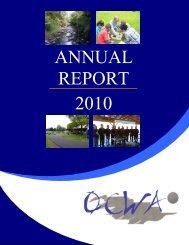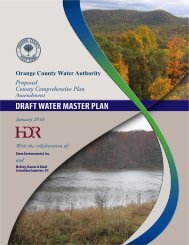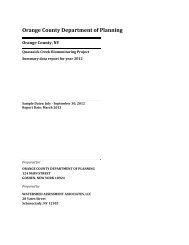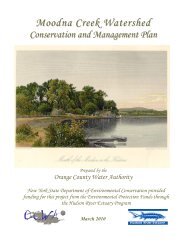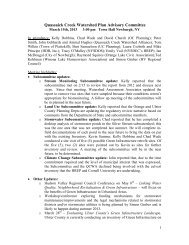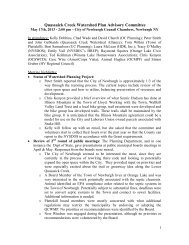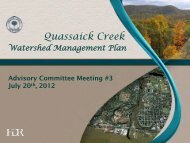Biodiversity of the Moodna Creek Watershed - Orange County Water ...
Biodiversity of the Moodna Creek Watershed - Orange County Water ...
Biodiversity of the Moodna Creek Watershed - Orange County Water ...
You also want an ePaper? Increase the reach of your titles
YUMPU automatically turns print PDFs into web optimized ePapers that Google loves.
<strong>Moodna</strong> <strong>Biodiversity</strong><br />
L. Heady, 19 June 2008 DRAFT<br />
Conclusions<br />
Whatever <strong>the</strong> scale, from making decisions at a site-plan review, to developing a town open<br />
space plan, or setting watershed protection goals, <strong>the</strong> key steps to conserving biodiversity<br />
resources are as follows:<br />
1) identify resources<br />
2) prioritize resources<br />
3) plan, protect, and manage resources.<br />
The <strong>Moodna</strong> <strong>Creek</strong> <strong><strong>Water</strong>shed</strong> Plan is a tool that residents, municipalities, conservation groups,<br />
county agencies, and o<strong>the</strong>r stakeholders can use to learn about <strong>the</strong> rich diversity <strong>of</strong> plants and<br />
animals that live in <strong>the</strong> watershed, and set priorities so that implementation efforts are effective<br />
and efficient, and reflect community values. It also can be used to identify gaps in information<br />
and set goals for future study and research. Finally, it can provide a planning framework to<br />
protect <strong>the</strong> biodiversity <strong>of</strong> <strong>the</strong> <strong>Moodna</strong> watershed, so that future generations will be able to live<br />
in healthy, quality communities and enjoy <strong>the</strong>ir natural heritage for a long time to come.<br />
Many <strong>of</strong> <strong>the</strong> recommendations outlined here reflect general conservation principles for<br />
protecting biodiversity. They include (adapted from Kiviat and Stevens 2001):<br />
• Consider habitat and biodiversity concerns early in <strong>the</strong> planning process.<br />
• Direct human uses toward <strong>the</strong> least sensitive areas, and minimize alteration <strong>of</strong> natural<br />
features, including vegetation, soils, bedrock, and waterways.<br />
• Protect large, contiguous, and unaltered tracts <strong>of</strong> habitats wherever possible.<br />
• Protect contiguous habitat areas in large, circular or broadly-shaped configurations within<br />
<strong>the</strong> larger landscape.<br />
• Preserve links between habitats on adjacent properties via broad connections, not narrow<br />
corridors.<br />
• Create, restore, and maintain broad buffer zones <strong>of</strong> natural vegetation along streams,<br />
along shores <strong>of</strong> o<strong>the</strong>r water bodies and wetlands, and at <strong>the</strong> perimeter <strong>of</strong> o<strong>the</strong>r sensitive<br />
habitats.<br />
• Maintain buffer zones between development and land intended for habitat.<br />
• Prioritize higher-quality habitats for protection, as degraded habitats decrease <strong>the</strong><br />
biological value <strong>of</strong> <strong>the</strong> larger ecological landscape.<br />
• Preserve natural processes such as forest fires, floodplain flooding, and beaver flooding<br />
to maintain <strong>the</strong> diversity <strong>of</strong> habitats and species dependent on such processes.<br />
• Preserve farmland potential.<br />
27



